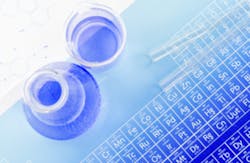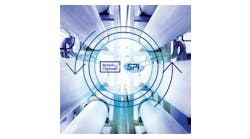In theory, how much sodium chloride or potassium chloride does it take to regenerate one ft3 of resin? Have you ever thought about it? The answer is 7.29 lbs. if the salt is NaCl and 9.3 lbs. if the salt is KCl. How do I know? The chemistry tells me.
Most water treatment professionals know that there are 5,989 grains as CaCO3 in each pound of NaCl salt and 4,695 grains as CaCO3 in each pound of KCl salt. However, do they know how much salt they can fit into that cubic foot of resin? This article will focus on the more common salt, NaCl.
Another interesting fact that a water treatment professional should keep in the back of his or her mind is that an eight percent DVB gel cation resin, which is typical and common in the water softener industry, contains a capacity between 1.9 and 2.0 meq/ml of resin. This is the range that resin manufacturers publish on their spec sheets. The range is due to batch to batch variation during the manufacturing process. If one converts these units to grains per cu. ft. we see that a cubic foot of typical eight percent DVB gel ion exchange resin for water softeners, when new, has between 41,499 and 43,683 grains per cu. ft. of exchange sites.
This means that if the process of exchanging ions was 100 percent efficient during regeneration, a salt dosage of 7.3 lbs./cu. ft. of NaCl salt would completely regenerate the resin. In other words, approximately 7.3 lbs. of salt contains 43,683 grains as CaCO3 of exchange potential. In reality, you will never be able to get the resin back to that capacity because real world systems are not 100 percent efficient. Yet, all water treatment professionals should know this benchmark value.
Ratio of equivalents in resin to equivalents from salt
The term stoichiometric is used to state that the theoretical maximum chemical exchange has occurred. So if we lived in a perfect world where perfect chemical exchanges could occur between a salt solution and ion exchange resin, then there would be absolutely no reason to regenerate a water softener above a salt dosage of 7.3 lbs./cu. ft. Figure 1 shows the ratio of equivalents in the resin ready to exchange positive salt ions to the equivalents from the salt at various salt dosages.
As one can see from the graph at the low salt dosages below 7.3 lbs./cu. ft., there are many more exchange sites available on the resin than are being provided by the salt solution. At one lb./cu. ft. salt dosage, there are 7.3 times more equivalents in the resin for the salt to attach to than there are equivalents being provided by the salt solution. This means that there is a very low probability that the salt solution equivalents could pass through the resin bed without being exchanged.
The decline is very rapid at first, but quickly flattens to nearly a horizontal line. This is why a water softener’s salt efficiency declines at high salt dosages. There are more equivalents being provided by the salt than there are available in the resin when the salt dosage exceeds 7.3 lbs./cu. ft.
In Figure 1, the decline is steep between one and 7.3 lbs. and very steep between one and five lbs. After 7.3 lbs. the decline is much more gradual because there are considerably fewer exchange sites on the resin for the sodium ion from the salt to attach itself.
In essence, a salt dosage beyond 7.3 lbs. means more wasted salt. Figure 1 shows the amount of salt wasted increases dramatically when the ratio of resin to salt equivalents drops below a value of one. Stated simply, the number of equivalents in the salt begins to outnumber the number of equivalents in the resin when the salt dosage is above 7.3 lbs./cu. ft. When this happens, more and more salt is wasted to drain as the salt dosage increases. Since water is used as the fluid to carry the salt through the resin during regeneration, more wasted salt means more wasted water; and in these times of drought, it is not healthy for the environment to use salt and water in excess.
The capacity of resin in salt dosages
Figure 2 shows a graph that is more commonly seen in our industry. The red line is what some resin manufacturers put in their sales literature. It shows the expected actual capacity of the resin at various salt dosages.
The black line is the theoretical line that increases at a constant slope of 5,989 grains capacity per lb. of salt added until the capacity reaches 43,683 grains. At that point there are no more equivalents available in the resin to exchange with the salt, and the resin is at the theoretical maximum capacity. Please note that between two and five lbs., the slope of the red line is nearly the same as the slope of the theoretical black line. That is why most of the efficiency rated softeners are salted in that range of dosages.
Between 25,000 and 30,000 grains/cu. ft. for the black theoretical line the salt dosage goes from 4.166 to five lbs./cu. ft., while for that same change in capacity, 25,000 to 30,000 grains/cu. ft. for the red line, the salt dosage needs to go from seven lbs. to 12 lbs./cu. ft. In other words, in theory it should take less than one lb. (0.834 lbs.) of additional salt to increase the capacity from 25,000 to 30,000 grains while in practice with today’s typical resins, it requires an increase of five lbs./cu. ft. to obtain that same 5,000 grain increase in capacity.
Setting a standard for ion exchange softener systems
We all know that there is no such system that produces 100 percent exchange of the salt with the resin. This article should provide a benchmark, or a comparison point, everyone in the industry should know, especially if they design ion exchange softener systems. My hope is that as more people become aware of this point of reference they will begin to design systems to operate at salt dosages at or preferably below, 7.3 lbs./cu. ft. Ideally, if all the new ion exchange softener systems installed were setup and designed to operate in the two to five lbs./cu. ft. salt dosage range, it would be a very good proactive first step.
In the long run, everyone will benefit because there will be less wasted salt and water, our sewer systems will have less chloride loading and our industry will improve its reputation. So the next time you’re at lunch with a colleague ask them, "Do you know how many pounds of salt can fit into one cu. ft. of resin?" and see where the discussion goes.
For resin:
1.0 meq/ml = 21,841.5 grains/cu. ft.
2.0 meq/ml = 43,683 grains/cu. ft.
For NaCl:
NaCl > Na+ + Cl– = 22.9898 + 35.453 = 58.4428
1 lb. = 7,000 grains:
So (22.9898 / 58.4428) x 7,000 grains/lb. = 2753.6 grains Na+ as Na+ per lb. NaCl
And
(2,753.6 grains Na+ as Na+) x (50 / 22.9898) = 5,988.7 grains Na+ as CaCO3 per lb. NaCl
So (43,683 grains / cu. ft.) / (5988.7 grains/lb. NaCl) = 7.294 lbs. of NaCl
Similarly for KCl:
KCl > K+ + Cl– = 39.102 + 35.453 = 74.555
So (39.102 / 74.555) x 7,000 grains/lb. = 3671.303 grains K+ as K+ per lb. KCl
And
(3671.303 grains K+ as K+) x (50 / 39.102) = 4,694.52 grains K+ as CaCO3 per lb. KCl
So (43,683 grains/cu. ft.) / (4694.52 grains/lb. NaCl) = 9.304 lbs. of NaCl


